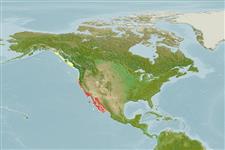Ikan bertulang rawan (sharks and rays) >
Squatiniformes (Angel sharks) >
Squatinidae (Angel sharks)
Etymology: Squatina: Latin for skate, which angel sharks superficially resemble, presumably tautonymous with Squalus squatina Linnaeus 1758 (no species mentioned). (See ETYFish); californica: -ica (L.), belonging to: California (USA), referring to type locality in San Francisco Bay. (See ETYFish).
More on author: Ayres.
Issue
It is sympatric with S. armata.
Environment: milieu / climate zone / depth range / distribution range
Ekologi
laut dasar (demersal); kisaran kedalaman 3 - 205 m (Ref. 9253), usually 3 - 46 m (Ref. 54903). Subtropical; 52°N - 7°N, 130°W - 77°W
Eastern Pacific: Canada to Gulf of California, south to Panama.
Length at first maturity / Size / Weight / umur
Maturity: Lm 97.0, range 86 - 108 cm
Max length : 152 cm TL jantan/; (Ref. 247); Umur maksimum dilaporkan: 35 Tahun (Ref. 6147)
deskripsi pendek
Kunci identifiaksi (pengenalan) | Morfologi | Morfometrik
Duri punggung (Keseluruhan (total)) : 0; Duri dubur: 0.
Found on the continental shelf and littoral areas (Ref. 247).A sluggish and inactive species that buries itself in sand or mud (Ref. 247). Also found around rocks, heads of submarine canyons, and sometimes near kelp forests (Ref. 247). Feeds on bottom and epibenthic fishes, including croakers, California halibut, and squid (Ref. 247). Ovoviviparous (Ref. 50449). Can whip up its head and snap very quickly when touched, provoked, harassed, or speared, and can inflict painful lacerations (Ref. 247).
Ovoviviparous, embryos feed solely on yolk (Ref. 50449).
Compagno, L.J.V., 1984. FAO Species Catalogue. Vol. 4. Sharks of the world. An annotated and illustrated catalogue of shark species known to date. Part 1 - Hexanchiformes to Lamniformes. FAO Fish. Synop. 125(4/1):1-249. Rome, FAO. (Ref. 247)
Status IUCN Red List (Ref. 130435)
penggunaan manusia
Perikanan: komersial
Alat, peralatan
laporan khas
muat turun XML
Sumber internet
Estimates based on models
Preferred temperature (Ref.
123201): 12.5 - 25.9, mean 21 °C (based on 60 cells).
Phylogenetic diversity index (Ref.
82804): PD
50 = 0.5000 [Uniqueness, from 0.5 = low to 2.0 = high].
Bayesian length-weight: a=0.00676 (0.00293 - 0.01558), b=3.07 (2.88 - 3.26), in cm total length, based on LWR estimates for this Genus-body shape (Ref.
93245).
Trophic level (Ref.
69278): 4.1 ±0.4 se; based on diet studies.
Daya lenting (Ref.
120179): sangat rendah, Waktu penggandaan populasi minimum lebih dari 14 tahun (K=0.15-0.16; tm=8-13; tmax=35; Fec=6).
Fishing Vulnerability (Ref.
59153): High to very high vulnerability (67 of 100).
Nutrients (Ref.
124155): Calcium = 17.5 [3.6, 86.6] mg/100g; Iron = 0.795 [0.206, 2.275] mg/100g; Protein = 19.9 [17.8, 21.8] %; Omega3 = 0.363 [0.162, 0.801] g/100g; Selenium = 26.5 [7.5, 76.0] μg/100g; VitaminA = 9.99 [3.53, 27.74] μg/100g; Zinc = 0.421 [0.203, 0.760] mg/100g (wet weight);
